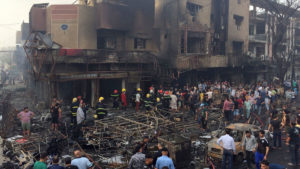by WorldTribune Staff, July 7, 2016
The death toll in an Islamic State of Iraq and Levant (ISIL) bombing in Baghdad on July 3 would have been much lower had it not been for locked exits and poor safety standards, an Iraqi general said.
Gen. Abdel Amir Shammari, head of Baghdad Operations, a joint force of police and soldiers that protects the Iraqi capital, said the initial blast at a mall in the upper-middle-class Karrada district was caused by C4 plastic explosives packed into a van. But he said the area around the shopping center was filled with “flammable materials” and that the paneling used for the building’s facade contributed as much, if not more, to the higher death toll, which has climbed to more than 250.

“The fire exits were closed specifically in that mall, and big numbers of people were in a café watching a football match,” Shammari said in a television interview on July 5.
Iraqi-British scholar Sajad Jiyad, who lives in Baghdad, said the mall, like most buildings in Baghdad, was designed with minimal fire safety features such as sprinklers. The building’s exterior was made of combustible plastic sheets, and the shops inside and outside the mall were filled with flammable materials. The nearest fire station was in another neighborhood and the fire engines that did arrive at the mall quickly ran out of water.
“The door to the roof was welded shut to prevent the entry of burglars,” he wrote in a blog post, after touring the bomb site. “The only way in and out of the building was through the single front entrance.”
“The explosion killed a small number of people instantly, but the subsequent fire that spread quickly trapped people in the mall and burned them alive,” Jiyad wrote. “Bodies that looked like they survived the fire were killed by smoke inhalation. In the basement, several bodies were found huddled close together, a desperate attempt to protect each other in the final moments. One father’s burned corpse was found shielding his daughter’s.”
Shammari said police believe the car bomb was assembled in Diyala province, northeast of the capital, which suggests it had to make its way through numerous checkpoints to get into one of Baghdad’s most important neighborhoods, a district adjacent to the fortress-like Green Zone.
